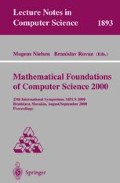Abstract
Maximum flow problems appear in many practical applications. In this paper, we study how to simplify a given directed flow network by finding edges that can be removed without changing the value of the maximum flow. We give a number of approaches which are increasingly more complex and more time-consuming, but in exchange they remove more and more edges from the network.
Supported by NSERC Research Grant.
Supported by NSERC Research Grant OGP0046506 and ICR Doctoral Scholarship.
Supported by NSERC Research Grant OGP0046506.
Access this chapter
Tax calculation will be finalised at checkout
Purchases are for personal use only
Preview
Unable to display preview. Download preview PDF.
References
Ravindra K. Ahuja, Thomas L. Magnanti, and James B. Orlin. Network Flows: Theory, Algorithms and Applications. Prentice Hall, 1993.
Therese Biedl, Broňa Brejová, and Tomáš Vinař. Simplifying flow networks. Technical Report CS-2000-07, Department of Computer Science, University of Waterloo, 2000.
Steven Fortune, John Hopcroft, and James Wyllie. The directed subgraph homeomorphism problem. Theoretical Computer Science, 10(2):111–121, February 1980.
Donald B. Johnson and Shankar M. Venkatesan. Using divide and conquer to find flows in directed planar networks in O(n3/2 log n) time. In Proceedings of the 20th Annual Allerton Conference on Communication, Control, and Computing, pages 898–905, University of Illinois, Urbana-Champaign, 1982.
Samir Khuller, Joseph Naor, and Philip Klein. The lattice structure of flow in planar graphs. SIAM Journal on Discrete Mathematics, 6(3):477–490, August 1993.
Franco P. Preparata and Micheal I. Shamos. Computational Geometry: An Introduction. Springer-Verlag, 1985.
Alexander Schrijver. Finding k disjoint paths in a directed planar graph. SIAM Journal of Computing, 23(4):780–788, August 1994.
Daniel D. Sleator and Robert E. Tarjan. A data structure for dynamic trees. Journal of Computer and System Sciences, 26(3):362–391, June 1983.
Karsten Weihe. Maximum (s, t)-flows in planar networks in O(¦V¦ log ¦V¦) time. Journal of Computer and System Sciences, 55(3):454–475, December 1997.
Author information
Authors and Affiliations
Editor information
Editors and Affiliations
Rights and permissions
Copyright information
© 2000 Springer-Verlag Berlin Heidelberg
About this paper
Cite this paper
Biedl, T.C., Brejová, B., Vinař, T. (2000). Simplifying Flow Networks. In: Nielsen, M., Rovan, B. (eds) Mathematical Foundations of Computer Science 2000. MFCS 2000. Lecture Notes in Computer Science, vol 1893. Springer, Berlin, Heidelberg. https://doi.org/10.1007/3-540-44612-5_15
Download citation
DOI: https://doi.org/10.1007/3-540-44612-5_15
Published:
Publisher Name: Springer, Berlin, Heidelberg
Print ISBN: 978-3-540-67901-1
Online ISBN: 978-3-540-44612-5
eBook Packages: Springer Book Archive

